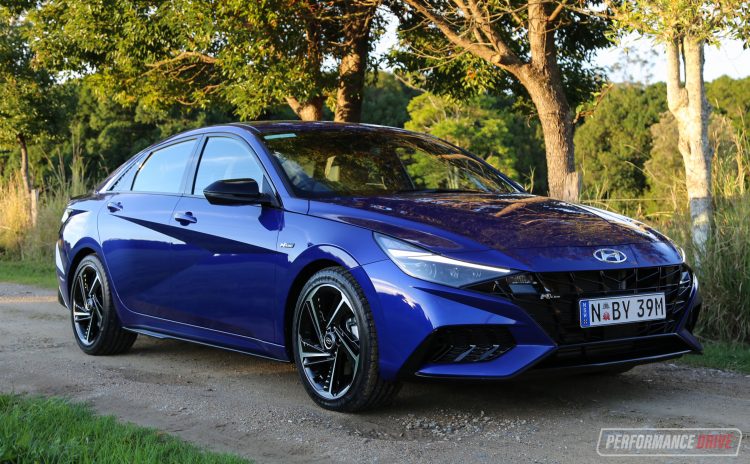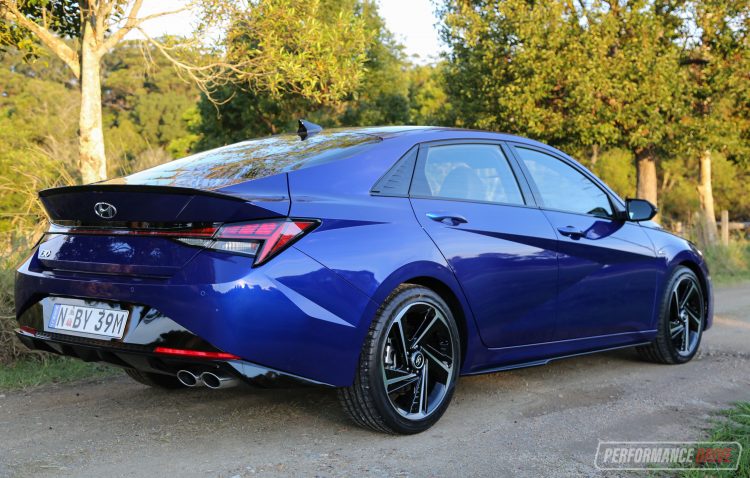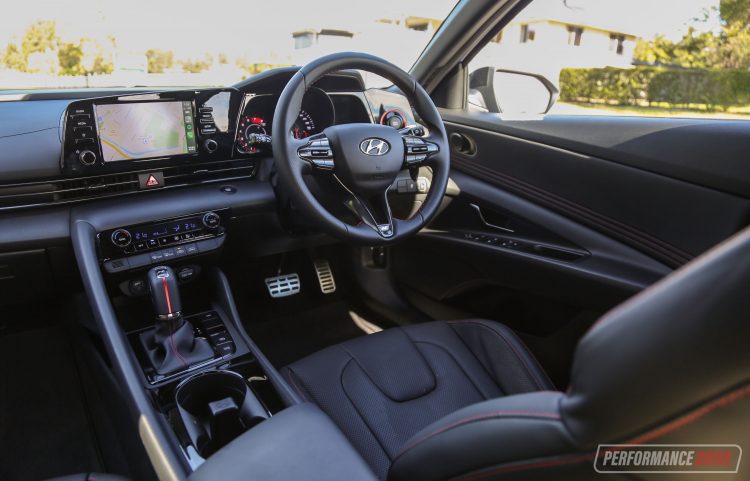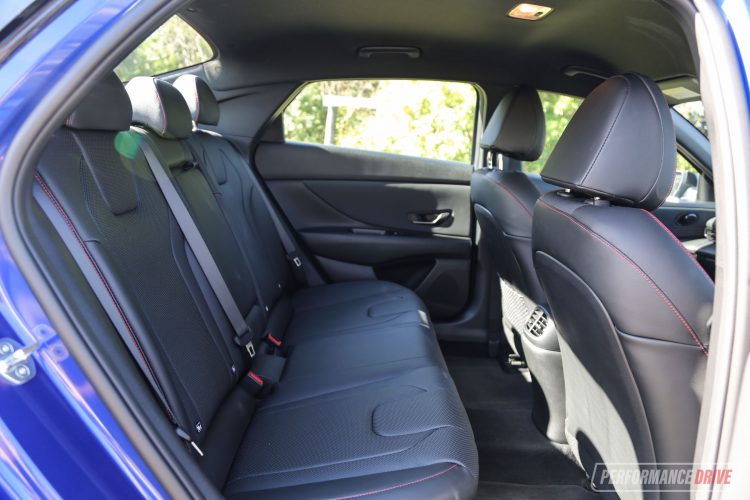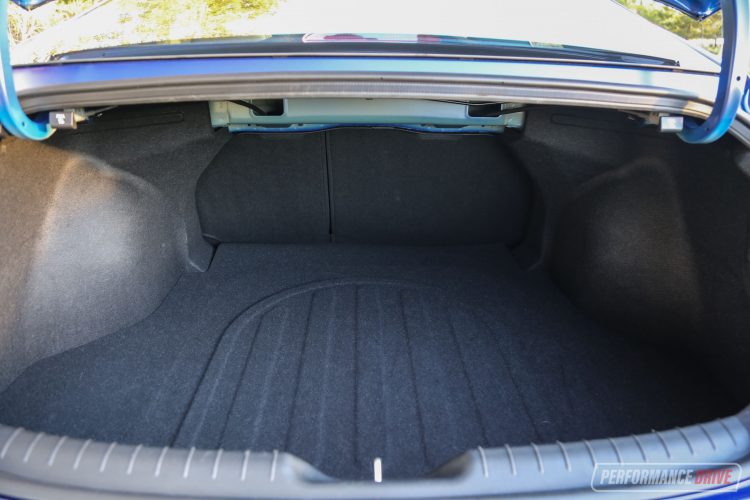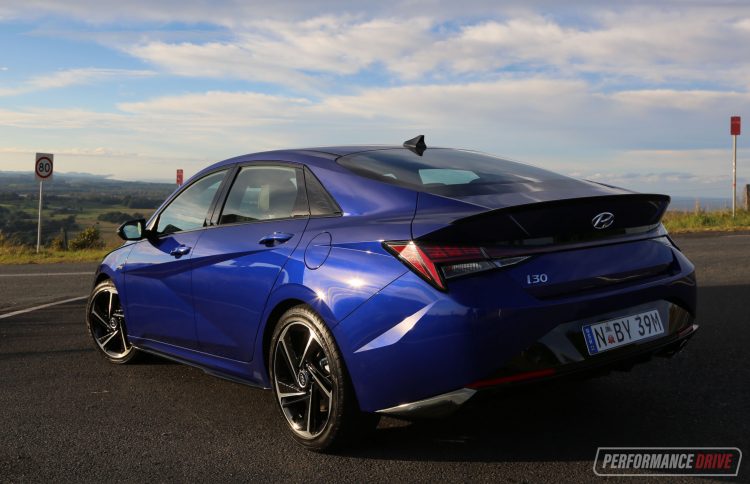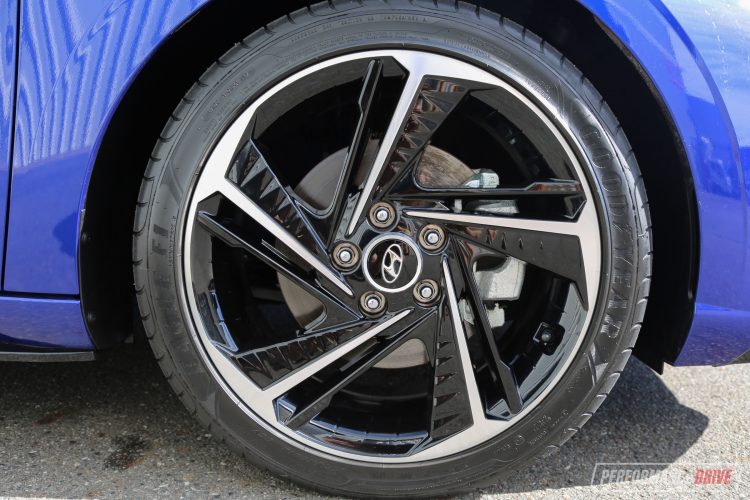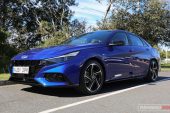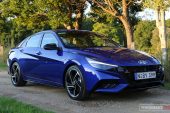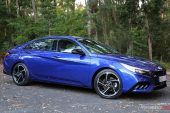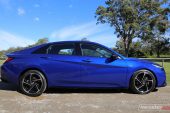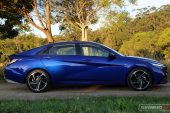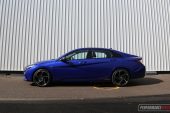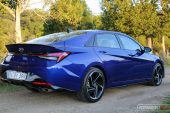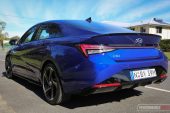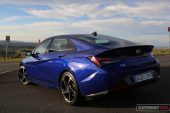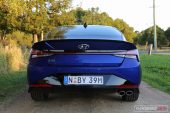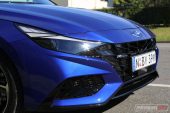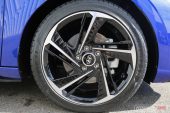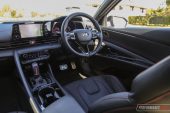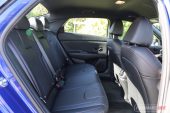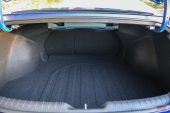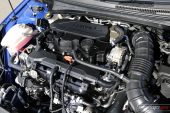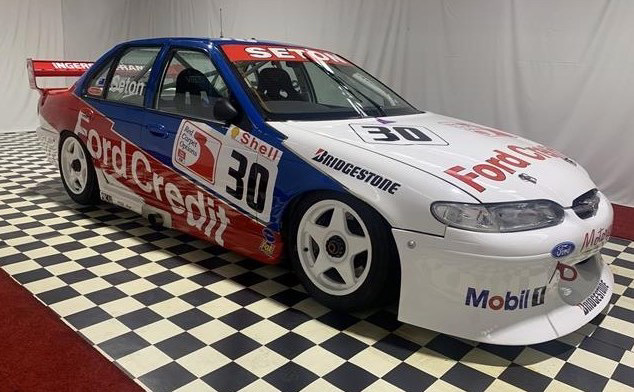Just when you thought the humble sedan was a relic of the past, Hyundai releases the new i30 sedan (previously Elantra in Australia), that not only shows Hyundai is committed to sedans, it’s actually investing heavily in them and transforming them into a more premium offering for the average buyer. This is heartening in a world burgeoning with SUV sales, and a timely reminder that a medium-sized sedan really is all the car a family needs.
The i30 sedan is based on a more sophisticated and elongated version of the i30 hatchback’s platform, and comes in four trim levels; the entry-level Active and Elite, the N Line sedan – which we’re testing here – as well as the N Line Premium.
The N Line sedan is billed as a sporty yet capable family car that takes the fight directly to its competitors in terms of handsome, futuristic styling, performance-based driving dynamics, a high quality interior finish, and a heap of safety tech as a proverbial cherry on top. It all looks very promising. Prices start at $32,690 for the N Line, or you can save $2000 by going with the manual (excluding on-road costs).
2021 Hyundai i30 N Line Sedan – THE SPECS
[column width=”47%” padding=”6%”]Engine: 1.6-litre turbo four-cylinder
Output: 150kW@6000rpm / 265Nm@1500-4500rpm
Transmission: Seven-speed dual-clutch auto
Drive type: Front-wheel drive
Wheels: F: 18×8.0, 235/40
ANCAP: Not tested
Tare weight: 1357kg
Power-to-weight: 9.04:1 (kg:kW)
Official fuel economy: 6.8L/100km
Economy during test: 6.2L/100km
Fuel capacity/Type: 47L/91 RON[/column] [column width=”47%” padding=”0″]Power efficiency: 22.05kW:L/100km
0-60km/h: 4.14 seconds*
0-100km/h: 7.77 seconds*
60-110km/h: 4.78 seconds*
1/4 mile: 15.91 seconds at 150.3km/h*
Max acceleration: 0.793g
100-0km/h braking: 2.76 seconds at 35.15 metres*
Max deceleration: -1.274g
Decibel at idle (/Sport mode): 38/40*
Peak decibel at 60-100km/h: 80*
Priced from: $32,690[/column][end_columns]
* Figures as tested by PerformanceDrive on the day. Factory claims may be different
2021 Hyundai i30 N Line Sedan – THE PACKAGE
The i30 N Line sedan rides on Hyundai’s K3 platform, which offers a longer wheelbase and more width than the K2 platform that underpins the hatchback. This means that while it might fit into the category of a small sedan, it actually offers the space and practicality that you’d expect from a medium-size offering. While it’s not our job to comment on the styling, we can make an informed guess that judging by the waitlists for the i30 sedan, Hyundai’s bold and futuristic aesthetic is going down a treat with the buying public.
In terms of equipment, the N Line adds a number of key features that you’d expect, as well as a few special touches. Special touches include a set of 18-inch alloy wheels, sports alloy pedals, and an N Line steering wheel – with wheel-mounted shifters – and gear lever, adding a significantly more premium and slightly sporty touch over the base i30 sedan’s interior.
As standard, the i30 N Line sedan comes packaged with dual-zone climate control, an 8.0-inch touch-screen infotainment unit with Apple CarPlay and Android Auto support, wireless smartphone charging, six-speaker audio system, keyless entry with push-button start, LED head and taillights, dual chrome exhausts, rear-view camera with parking sensors, rear air vents and adaptive cruise control.
Keep in mind that if you’re looking for Hyundai’s latest, larger 10.25-inch touch-screen and fully digital instrument cluster, front parking sensors, electronically-adjusted heated and ventilated seats, a sunroof, and Bose sound system, you’ll need to spend some extra dough to step up to the N Line Premium variant, which starts from $37,690 (auto only).
All up, though, the base N Line sedan’s cockpit is extremely spacious and designed to shoot up at its more premium European rivals. There’s sloping surfaces with red contrast stitching, premium-looking leather seats with bulky side bolsters, and a large feature on the centre dash separating the driver and passenger that doubles as a storage spot and hand rail for the passenger, if the driver is feeling adventurous. In terms of practicality, there isn’t a lot of options for larger bottles, although smaller, loose items will find their way into the array of compact stash spots in the front.
In the rear, the longer wheelbase has no doubt made a huge difference for rear legroom, which, even with a tall driver at the helm, can comfortably seat adults and with no lack of headroom, either. This car can and will comfortably accommodate a family for a long road trip, and it’ll eat up luggage, too, because there’s 474L of cargo space in the back.
2021 Hyundai i30 N Line Sedan – THE DRIVE
This is where things get interesting. Hyundai has positioned the i30 N Line sedan as a sporty yet practical offering for the family, so how well does it hit that brief?
The 1.6-litre turbocharged engine kicks up 150kW and 265Nm, paired with a seven-speed dual-clutch transmission that sends power to the front wheels. While the front-wheel-drive layout might not be everyone’s favourite, the front tyres do a great job at throwing down the power and getting you up to road-legal speeds in no time, and without a fuss. Peak torque comes in early at 1500rpm and leaves at around 4500rpm, so there’s no need to wring its neck out. Rather, the task of short-shifting through the wave of torque is enjoyable and effortless.
The steering has a nice amount of weight to it, and offers the driver enough feedback to feel what the front wheels are up to, and how they’re handling the power. Thanks to independent suspension and firm dampening, the chassis is actually able to withstand a huge amount of punishment before the front wheels inevitably move wide. This point is so far beyond anything you’re likely to do on the road, though, so you’ll be impressed at its ability to stay flat and agile in the corners.
That hasn’t come without a cost to everyday driveability, though. While Hyundai is known to tune its vehicles for Australia’s road conditions, the i30 sedan is definitely better suited to smooth, predictable surfaces. It’s by no means uncomfortable, though, and Hyundai’s attention to reducing noise, vibration and harshness inside the cabin is clear to be seen, offering an extremely comfortable and silent drive. This is especially important during long trips away.
On those trips, you’ll be delighted at just how quiet and competent the i30 is, especially with the adaptive cruise control system and lane-keep assist. This is perhaps the car of the segment for grand touring, and all your guests will be certain to point out just how nice the cabin is for the price.
As an everyday drive around town, the i30 N Line sedan is near faultless. The transmission works well for this type of gearbox, although not without some hesitancy while navigating intersections and roundabouts. But Hyundai has obviously tried to calibrate the dual-clutch unit to operate as smoothly and seamlessly as possible. The powertrain and transmission combination mean you can get up to speed remarkably quickly and comfortably, often defying what you’d expect from a car of this price.
Three things that you should be aware of, particularly if you’ve already had time behind the wheel of an SUV or compact SUV. The large rear pillar that impedes visibility and can make the first stages of parking more difficult. The low ride height can be strenuous when getting in and out. The front splitter can also scrape on steep driveways. If you’re willing to rough out those admittedly small details, though, you’re almost certainly going to love the i30 N Line sedan.
In terms of fuel economy, after more than 16 hours, covering 800km on the highway and around town, we averaged 6.2L/100km. That’s better than the official average of 6.8L/100km. Again, this reiterates how suitable this car is as a grand tourer.
2021 Hyundai i30 N Line Sedan – THE VIDEO
2021 Hyundai i30 N Line Sedan – THE VERDICT
The Hyundai i30 N Line sedan is such a capable car that we often found ourselves comparing it to what’s on offer in significantly more expensive market segments. It is generously equipped, presents a striking design, and features an exciting yet economical powertrain.
This car truly punches above its weight in a number of categories, and we’re pleased to see that Hyundai is committed to entertaining buyers that have a family, but want to maintain the style and driving dynamic of a sedan shape.
Considering just how well equipped the standard i30 N Line sedan comes in its base form, we don’t really see the need to step higher into the range and opt for the N Line premium. Unless you’re unwavering when it comes to features like a sunroof, larger infotainment system and heated seats, we think the entry-level N Line sedan is the pick of the bunch.
[column width=”47%” padding=”6%”]PROS:
– Outstanding value for money; stylish, sporty, practical, and premium
– Engine and transmission combination; performance and economy
– Interior quality, fit and finish[/column] [column width=”47%” padding=”0″]CONS:
– Firm ride on ordinary country roads
– Transmission can lurch at slow speeds[/column][end_columns]
As always, if you’re thinking about buying a new car don’t forget to click here to speak with our car buying specialists.
